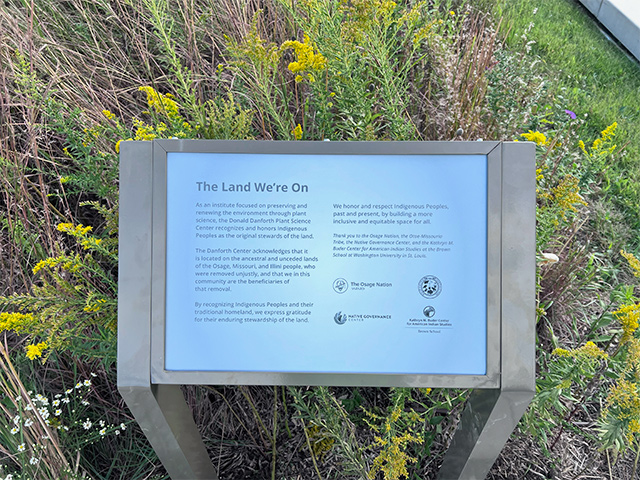Celebrating Indigenous Peoples’ Day
The six acres of reconstructed tall grass prairie that surround the Danforth Center are a meaningful reminder of what Midwestern landscapes used to look like. Long before the Danforth Center, Olive Boulevard, or St. Louis were established, prairies dominated most of the region.
Centuries of these healthy, native landscapes and their deep-rooted perennials are directly responsible for the fertile soil that the Midwest continues to benefit from today. On Indigenous Peoples’ Day, we celebrate and honor the Native Peoples who stewarded this land. This year, in celebration of that legacy, we have installed a plaque acknowledging this history in our prairie. There, all those who pause to enjoy the beauty of the wildflowers and grasses will have the opportunity to learn and reflect. The plaque states:

Plaque acknowledging this history of the Donald Danforth Plant Science Center prairie.
As an institute focused on preserving and renewing the environment through plant science, the Donald Danforth Plant Science Center recognizes and honors Indigenous Peoples as the original stewards of the land.
The Danforth Center acknowledges that it is located on the ancestral and unceded lands of the Osage, Missouri, and Illini people, who were removed unjustly, and that we in this community are the beneficiaries of that removal.
By recognizing Indigenous Peoples and their traditional homeland, we express gratitude for their enduring stewardship of the land.
We honor and respect Indigenous Peoples, past and present, by building a more inclusive and equitable space for all.
Thank you to the Osage Nation, the Otoe-Missouria Tribe, the Native Governance Center, and the Kathryn M. Buder Center for American Indian Studies at the Brown School at Washington University in St. Louis.
The Danforth Center prairie is open to the public. We hope you will visit our campus sometime soon and take a moment to stop and consider the message of our new plaque.